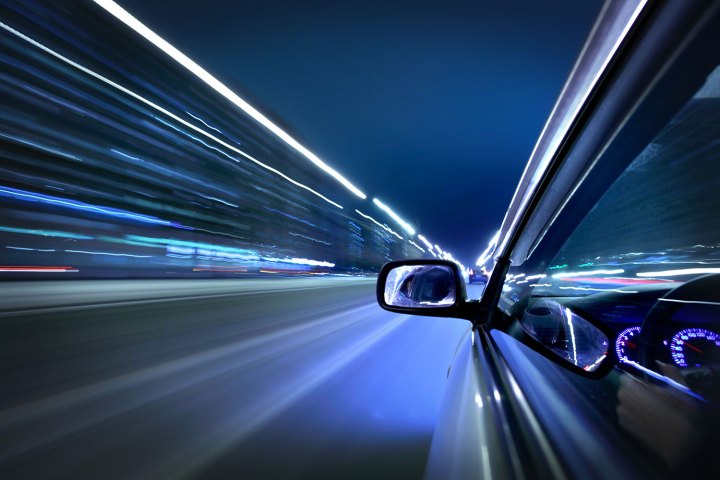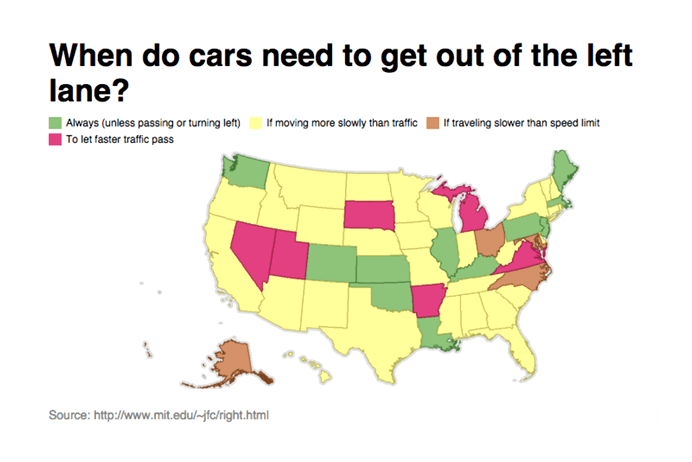
The lack of practice and understanding concerning when and how to use the left lane has far greater impact than you might imagine.
At the onset, I can group this article’s readership into two camps: those who deny any wrongdoing in using the left lane like any other lane, and those who (perhaps fiercely) acknowledge that the left lane is for passing only. I’ll attempt to convince those in the former club of the error to their ways, but if I should fail, at least state governments across the nation have my back.
Regulations From Each State
In truth, many drivers are completely unaware of the regulations concerning left lane driving protocol (perhaps it was one of the questions they got wrong on their permit tests), so allow me to educate: each state has some law (to greater or lesser degrees of punishment) about driving in the left lane on highways and multi-lane roads.
Here’s how those regulations break down between states (data courtesy of MIT). The 29 states in yellow declare that any vehicle moving slower than the “normal speed of traffic” should be in one of the right lanes. Whether you’re going the speed limit or not, if the traffic pace is faster than your own, you’re required to move over. The 11 states in green up the ante to say the left lane is only for turning or passing. The 10 remaining states require drivers to either yield to faster traffic in the left lane, or to only occupy the left lane if they’re matching the speed limit.

Beyond the above state laws, the uniform vehicle code says, “upon all roadways, any vehicle proceeding at less than the normal speed of traffic at the time and place and under the conditions then existing shall be driven in the right-hand lane.” Note that “normal speed of traffic” does not equate to “speed limit” but rather the average pace. Translation: you belong in the right lane if you aren’t at least going as fast as those around you. Unfortunately, as I’ll elucidate, this code isn’t encompassing enough.
Chances are, you haven’t been pulled over for driving slowly in the left lane, but be aware that in many states, you’re breaking the law. Georgia has even given police authority to hand over misdemeanor tickets to anyone who doesn’t yield to faster traffic when in the left lane.
“But,” some protest, “if I’m going the speed limit in the left lane, that means anyone who passes me is breaking the law!” This argument, among others is the common defense for left lane protocol naysayers. Let’s tackle this concern.
The Impact of Left Lane Hogging
To elaborate upon the above argument, some drivers either do not see the issue with using an available left lane to travel at the speed limit, or see actively “controlling” the speed of the left lane as a civic duty to prohibit would-be speeders.
In truth, many drivers are completely unaware of the regulations concerning left lane driving protocol.
To address the first group of drivers, consider the impact of holding up passing traffic. 10 percent of all traffic accidents are caused during lane changes. Whether you’re traveling at the speed limit, below it, or even above it at the traffic’s pace, one or more vehicles will seek to pass you. The law advises vehicles to use the left lane for passing, but those determined to pass will use any available lane to pass if the left is occupied. By holding up the passing lane, you’re part and parcel to endangering vehicles around you when a driver must use a right lane to overtake you. When all vehicles expect passing to occur to the left, a pass to the right can disturb the flow of traffic and cause an otherwise avoidable accident.
As for the vigilante crowd, consider two things: the first is that, as stated above, drivers who are determined to pass will do so via conventional or unconventional means. While you may think you’re stopping would-be speeders, you’re actually just introducing them to slower lanes of traffic, raising the potential for accidents. The second argument against your “public service” is a simple one; if you really want a speeder to “learn a lesson,” which is a better instrument: a hefty fine from a police officer, or a delay from being stuck behind your vehicle, thereby causing him or her to grow in frustration and perhaps convincing them to go faster to make up for lost time?

In short, it is no ones “job” to prevent speeders, and in many situations, taking up the fight against speeders endangers everyone on the road far more than an unimpeded speeder. Consider also that clearing the left lane makes it easier for the police – whose actual job it is to enforce the law – to identify the would-be traffic infractor left lane justice jockeys are trying to “punish.”
The Impact of Clearing Left Lanes
To bolster the case for pass-only left lanes, we can simply look to Europe’s code of conduct. European nations with greater police enforcement and more established etiquette in regards to left lane driving enjoy far fewer accidents. In Germany, where 50 percent of its roads are without speed limits, traffic flows well in large part thanks to the ingrained notion of a passing lane. For drivers who don’t comply with left lane discipline, punishments include $200 to $800 fines, or even license suspensions.
Whether you’re traveling at the speed limit, below it, or even above it at the traffic’s pace, one or more vehicles will seek to pass you.
These driving standards lend themselves to far fewer traffic fatalities than the U.S. According to the World Health Organization, in 2013, Germany had 6.8 traffic deaths per 100,000 motor vehicles on the road. By comparison, the U.S. had 12.9 deaths – almost double. The trend isn’t improving in the U.S. either, with a 9.3 percent uptick of total traffic fatalities in the first nine months of 2015 (26,000) compared to the previous nine months in 2014 (23,796). Like Germany, equally regulated nations such as Switzerland, Great Britain, Finland, Norway, Germany, the Netherlands, Denmark, Australia, and France all have fewer traffic deaths than the U.S.
Though distracted driving factors are becoming an increasing concern (in the U.S. and abroad), just as poignant is this nation’s reluctance to follow standardized traffic behavior. Since 2007, the National Motorists Association has promoted Lane Courtesy Month in June to raise awareness about how a clear left lane can improve traffic flow, prevent accidents, and save drivers money on gas. If that last point stumped you, consider when a vehicle is most fuel-efficient: when it’s maintaining a consistent speed. With a pass-only left lane comes reduced congestion (faster vehicles do not need to forcibly enter slower lanes of traffic, forcing other cars to slow) and therefore smoother, consistent travel for all lanes.
Standardizing Change
Hopefully these arguments for yielding the left lane to passing traffic have resonated with you, and if so, I’ll offer some simple guidelines for eliciting change on U.S. roadways. Though it’s difficult to alter habits that have built up over time, some basic situational awareness can lead to safer traffic flow.
As you’re driving along, take note of surrounding cars. Are vehicles to your right passing you? If so, it’s time to move over a lane to the right. This doesn’t just apply to driving in the left-most lane. To aid in the standard of “pass on the left,” even middle-lanes have their own pacing ecosystems. Even if you end up in the right-most lane when following the above rule, it just means faster traffic is safely passing to your left.
In the same way that there will always be drivers who break the law by speeding, not signaling during lane changes, or any number of other violations, there will certainly be drivers who neglect the left lane principle. However, each driver has equal opportunity to obey these laws and benefit from safer, smoother, and more efficient traffic patterns.


